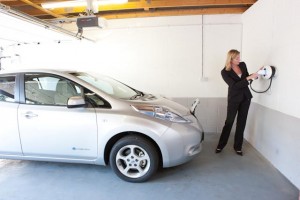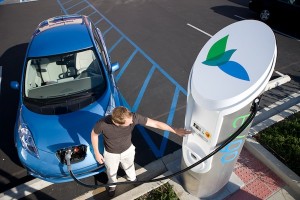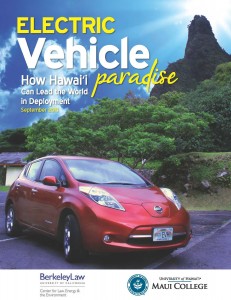The California State Department of Housing and Community Development (HCD) issued proposed new building code standards last month that vastly promotes electric vehicle charging infrastructure in new home construction. It’s much more costly to wire a home for “Level 2” or 240V charging once it’s already built, while relatively cheap to do it when the house is already under construction:
The new code will ensure that the conduit and service panel capacity is already there, making installation a simple matter of running wires and bolting charging stations into place. By one estimate, the average cost of compliance will be around $50, a fraction of the potential savings to residents who choose to install charging stations. For one- and two-family dwellings, the service panel must have capacity for a 40-amp circuit (sufficient for a 32-amp charging station), and conduit that can support wiring for an 80-amp circuit.
The new standards also call for parking lots with 100 spaces to have conduit and service panel capacity to wire at least 3 percent of the parking spaces.
This change is welcome news for future EV drivers and home buyers/renters in California. A Level 2 charger offers a lot more convenience than the traditional 110V wall outlet. For example, when I plugged our electric vehicle into a regular wall outlet, the battery charged at about 5 miles an hour (one hour of charge gave me an extra five miles of driving). But after we installed a Level 2 charger, we could get at least 20 miles of range for every hour of charge. It means we never need to worry about the battery being too low and having to make sure to plug in every night before bed.
I hope California’s actions inspire other states, as the country moves to electrify passenger vehicles at an increasing rate.
Back in 2011, California regulators banned the state’s electric utilities from owning and operating electric vehicle charging equipment. Part of the logic was that utilities would crowd out innovation, using their monopoly power and capital resources to dominate the market.
 But so far, electric vehicle charging infrastructure in the state is rolling out poorly. eVgo, the company that received a $100 million state mandate to deploy charging infrastructure, is way behind schedule. Many existing charging stations are crowded and too few and far between, while the equipment is unreliable and often unavailable when you need it. Meanwhile, competing charging companies have developed cumbersome “networks” that you have to sign up for in order to access their chargers, instead of just having a simple, universal payment method like a gas station credit card reader.
But so far, electric vehicle charging infrastructure in the state is rolling out poorly. eVgo, the company that received a $100 million state mandate to deploy charging infrastructure, is way behind schedule. Many existing charging stations are crowded and too few and far between, while the equipment is unreliable and often unavailable when you need it. Meanwhile, competing charging companies have developed cumbersome “networks” that you have to sign up for in order to access their chargers, instead of just having a simple, universal payment method like a gas station credit card reader.
So is it time to call in the cavalry (i.e. utilities) to flood the market with cheap charging? San Diego Gas & Electric would certainly like to get that call. The company recently proposed a “pilot project” that looks more like a large-scale EV charging effort:
The [vehicle-grid integration] pilot is an “innovative hourly time-variant rate and associated grid-beneficial charging infrastructure,” SDG&E said, calling for authorization to develop 5,500 charging stations targeting multi-family dwellings and workplaces between 2015 and 2025. The VGI pilot would require approximately $59 million in capital costs and $44 million in operations and maintenance over the life of the project.
The California Public Utilities Commission has punted consideration of this pilot to the larger proceeding dealing with the question of electric utility involvement in charging more generally. That proceeding may issue a ruling in December.
From my perspective, the current charging infrastructure is inadequate and frustrating. Limited involvement by utilities might be welcome, provided that it’s done on a small scale to make sure we don’t unleash a beast. Perhaps the SDG&E pilot, or a smaller version of it, could be a good first step. The ultimate resolution of these issues will of course depend on careful fact-finding at the proceeding and input from stakeholders. But the bottom-line focus should be on the provision of cheap, reliable, ubiquitous, and easy-to-use charging for EV drivers.
Auto dealerships may be falling down on the job when it comes to selling electric vehicles. A new policy brief by UC Davis Policy Institute for Energy, Environment and Economy analyzed consumer surveys and conducted interviews with automakers and dealers. The report reveals:
large across the board deficits on every facet of the [electric vehicle] purchase experience, notably salesperson knowledge and expertise about the vehicle.
Tesla was the notable exception. The company has made headlines fighting state-level policies that restrict automakers from direct sales to customers, and this survey indicates why: Tesla can do a much better job selling their cars than a disinterested franchise dealer. As the report notes,
Tesla’s elimination of steps that add little or no value at the retail facility (e.g. price negotiations, paperwork, and waiting) shifts efforts toward more PEV-specific support that likely bolsters customer satisfaction scores.
I’m not surprised by the negative findings. I found a similar dynamic when I researched electric vehicle policies in Hawaii. Many sales reps there were unfamiliar with electric vehicles and not motivated to sell them. They couldn’t answer basic questions about how the vehicles perform. In one case, a dealer owner on the Big Island was apparently openly hostile to the idea of electric vehicles and refused to sell them at all, despite the strong economics there (he’s since reversed course and is now selling them). By contrast, when I leased my electric vehicle from a California dealer that was a top-seller for EVs, the salespeople were very knowledgeable and helpful.
If automakers are serious about selling electric vehicles, they need to work the carrots and sticks to get their dealers familiar with the cars and motivated to sell them. At a minimum, at least one sales rep on-site needs to drive one for an extended period of time. Only through consistent use can they 1) understand the challenges and options available and 2) develop a feel for the positives these cars bring to the driving experience.
The Economist highlights a new report that says that electric vehicles could solve the electric utility “death spiral.” This spiral is projected to occur as more customers go solar and use less electricity overall, which means fewer customers to pay for the electricity infrastructure. Then rates go up on the remaining customers, which encourages them to go solar and buy batteries. And spiral ensues.
But is electric vehicle help on the way?
A modest 250,000 plug-in cars now glide silently along American roads, and they currently account for fewer than 1% of vehicles sold. But sales have been almost doubling each year (compared with about 5% annual growth for the entire car industry), and homes that own a plug-in car typically consume 58% more electricity, according to Opower, a seller of energy-conservation software. The Edison Electric Institute, a power-industry trade body, recently issued a report that called plug-ins a “quadruple win” for utility companies. In other words, they could help the industry increase demand, meet environmental goals, get closer to customers and cut costs by electrifying its own vast vehicle fleets.
The problem though is that many EV drivers get rooftop solar, so that negates the bounce in electricity usage. A better solution for utilities, as the article hints, is for them to fully embrace these new technologies, from EVs to rooftop solar to battery backup storage to EV charging facilities. In some case, regulations prevent them from engaging in these new lines of business. But if they were smart, they’d aggressively try to enter this market, offering customers an array of new technologies.
The reality though is that utilities are generally too risk-averse to be aggressive in this way. As incumbents, they’d rather try to strangle these new technologies in the crib. And maybe that stance is best for society anyway. After all, the utilities will likely fail in those efforts, and we may not want them (literally) monopolizing the new technologies. Perhaps it’s better to have utilities serve as a retail platform on which multiple companies can compete for customer services, with on-site renewables, energy storage, electric vehicle charging, and energy efficiency programs.
Electric vehicles are unlikely to be the savior alone, but they could help prompt utilities to re-imagine their future. Because as it stands now, the present course for utilities is not sustainable.
The UCLA/Berkeley Law webinar on repurposing electric vehicle batteries for grid storage is now on-line. The September 19th event discusses key recommendations from the new report “Reuse and Repower” and features Adam Langton, Senior Energy Analyst at the California Public Utilities Commission, and Randall Winston, Special Assistant to the Executive Secretary in the Office of Governor Brown.
You can watch the one-hour video here or below:
Electric vehicles in Hawaii should be a no-brainer. The limited island geographies make battery “range anxiety” either easy to solve through a few public charging stations or practically non-existent. The high gas prices make driving economically painful. And the abundant renewable energy there (solar, wind, and geothermal) means lot of potential for cheap, clean electricity.
But the U.S. Department of Energy “eGallon” website shows a critical disconnect. In most states, the equivalent “miles per gallon” of using electricity instead of gas for driving results in huge savings. The average U.S. gallon of gas costs $3.52, while the equivalent cost in electricity is $1.27. Pretty nice amount of savings, no?
 Well, in Hawaii, we have an outlier result. The extremely high cost of electricity (most is generated from burning imported diesel), coupled with the high cost of gas, results in an unfortunate comparison: $3.79 for a gallon of gas vs. $3.75 in equivalent electricity costs. So you’ll save 4 cents per gallon going electric! Pretty weak.
Well, in Hawaii, we have an outlier result. The extremely high cost of electricity (most is generated from burning imported diesel), coupled with the high cost of gas, results in an unfortunate comparison: $3.79 for a gallon of gas vs. $3.75 in equivalent electricity costs. So you’ll save 4 cents per gallon going electric! Pretty weak.
That’s where rooftop solar comes into play. For residents of Hawaii with these systems, they can pay almost nothing in electricity through the state’s net metering program. This arrangement makes the savings from going electric probably greater than in almost any other state. In fact, in researching the report “Electric Vehicle Paradise” for Berkeley Law and Maui College last year, almost everyone I talked to who had purchased or leased an EV in the islands had rooftop solar. And they were motivated to go electric because they were producing too much solar from their roof.
That’s why our report recommended that Hawaii’s utilities, especially Hawaiian Electric (HECO), remove barriers to installing rooftop solar. At the time, the utility privately claimed to me that they really didn’t have any barriers, such as expensive interconnection studies. But shortly after we released the report they began clamping down aggressively on rooftop arrays with these studies.
But change is in the works. In response to an aggressive state public utilities commission directive, HECO now plans to go 65% renewable by 2030, which is great. But the utility wants to impose a fixed monthly charge of $55 on solar customers, which could undermine the economics of going solar. And HECO still needs to get rid of phony “interconnection studies” that can cost thousands of dollars for a property owner trying to install solar.
With rooftop solar, particularly in Hawaii, it’s not just about cleaning the electricity system — it’s about driving cleaner, too. Not to mention that more EVs ultimately boosts energy storage in the islands from repurposed electric vehicle batteries. So let’s hope HECO does the right thing, because the whole movement to a cleaner, cheaper energy system in Hawaii starts with solar.
The New Yorker runs a really frustrating article from a disgruntled EV owner. This Angeleno has no dedicated parking or charging at home and is relying on the public charging network. He rightly describes the frustrations with that network — the breakdowns, congestion, and inconvenience of it all.
But honestly: why would someone without dedicated home charging get an EV? The public charging network is just not there right now. The initial EV market needs to focus on people who can charge at home — or at least at work. Once you get that market ramped up and improve public charging (including more dedicated charging in condos and apartment buildings), automakers can expand the market to others.
That may not be of great comfort to those without dedicated home charging, but it’s the reality for an emerging technology.
Given that reality, why would the New Yorker privilege a story that highlights the inconveniences of a non-representative EV owner? And meanwhile, the national media is running all sorts of negative stories on EV sales, while LEAFs have record-setting sales.
I guess the bad story sells better, but it’s unfortunate to see this misleading picture presented to the general public.
I always feel guilty talking to apartment or condo dwellers about the joys of electric vehicles. Without a dedicated parking spot with access to an outlet, they’re basically out of luck. Maybe if you have workplace charging, you can make it work. But otherwise, it would be unwieldy to have to rely on a spread-out public charging network to keep your vehicle battery full.
But there may be a way to blanket urban areas with EV charging spots. The answer? Streetlights. Cities already have extensive wiring in place for these lights, and they’re not used during the day. So that excess capacity could be harnessed to install street chargers without requiring expensive and invasive electrical work. A few companies seem to be all over this possibility, just based on a quick Google search.
Of course, there would be challenges to work out. For example, how do you ensure that the chargers are only active during the day or when there is excess capacity on the streetlight grid? Installing LEDs and other efficient lighting technology could help at night to free up capacity (assuming the lamps aren’t already more efficient), but daytime may not be the optimal time to charge for daytime workers who may be gone then. And who pays for the install? Is there a viable business model where the chargers earn enough to cover the installation and maintenance costs?
These are just a few questions that spring to mind. But it’s an intriguing possibility that would help solve the otherwise seemingly intractable problem of providing ubiquitous charging in compact urban environments — and therefore opening the EV market to a whole new segment of potential buyers.
Sometimes I get that feeling that the pro-transit (or pro-walking/biking) crowd is uneasy about the subject of electric vehicles, if downright negative. Why? Many transit advocates don’t like cars — viewing them as dangerous to bikers and pedestrians (which they are). They also don’t like how cars chew up the environment and create terrible traffic and isolation.
Not only that, but electric vehicles are frequently cited by transit critics as a reason to continue business-as-usual development patterns, in which we continue to build communities around cars, as opposed to walking- and biking-friendly communities oriented to transit. After all, if we’re moving toward electric and other clean vehicles, who cares any more about the pollution and negative public health effects from sprawl?
Certainly the advent of electric vehicles undercuts a key argument in favor of transit and more human-centered communities. It’s true that electric vehicles, if we can get there fast enough, will solve much of the pollution and public health challenges from sprawl. But it will take decades (most likely) to fully transform our existing fleet of cars to electric, as the technology is not fully developed and at this point not appropriate for all types of vehicle usage. So the public health and pollution problems from unabated sprawl will continue. But the writing, I believe, is on the wall for a cleaner transportation system.
So where does that leave public transit advocates in the long term? Well, we have to remember that the arguments against sprawl and in favor of more convenient, connected communities oriented around transit are not just limited to reducing pollution. Traffic is a miserable economic drag on our economy and quality of life. Biking and walking is fun and good for you, and it leads to communities with more social interaction, particularly for children, the elderly, and those who can’t or won’t drive. California’s severe housing shortage and changing patterns of demand argue in favor of building as many homes and jobs as we can around transit. And sprawl continues to eat up our valuable farm land and open space, as well as sensitive ecological areas.
I’m certainly in both camps. I love transit, use it every day, and walk and bike as much as possible. But I also see the need for electric vehicles. Not everyone can rely on non-vehicle forms of mobility for all their needs. Cars are here to stay. So we need to transition our fleets to clean vehicles. We also need to invest in battery technologies as a crucial way to decarbonize the electricity grid. Plus, electric vehicles are fun to drive (this from someone who never cared about cars or driving before).
Ultimately we’ll need both technologies going forward, and I don’t think anyone should hesitate to advocate for both.
For those in the San Francisco Bay Area, I’ll be on KCBS news radio (740AM) at 8:20am discussing the new UCLA/Berkeley Law report on repurposing used electric vehicle batteries for inexpensive grid storage. The report has gotten some nice coverage from Forbes, Scientific American, Charged Magazine, and the Daily Californian at UC Berkeley. Hope you can tune in!
UPDATE: You can listen to the broadcast here.




